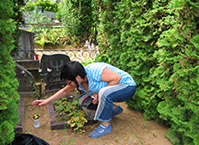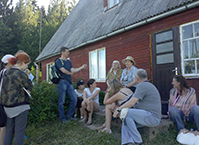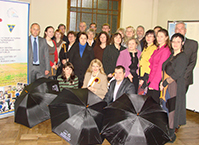About holidays and traditions
Categories: Holidays and traditions, Antonina Ludborza
Story-teller: “But at the New year … So then, at the New year’s eve we always poured lead [to learn the future]. The youth … We can say, that no year passed and, no New Year’s Eve passed, without pouring lead. We, young people, gathered in the village. We had one such public house here, there, at Barkāni, in the very centre of Kristinki, both … both older people and the youth gathered, so, we gathered there, and there we poured lead. And also those even… again, as we gathered on ordinary Sundays, we were telling different fairy-tales.”
Interviewer: “Do you remember any fairy-tale?”
Story-teller: “You know, I’ll tell you, there was an old man, he was hundred years old when he died, he was a hundred years old. He was crooked, crooked, so crooked, he walked, you see, stooping, poor man. He told us some very very long fairy-tale, I don’t remember it anymore, I just know that it was about two boys Basentinsh and Tureite, those were their names in that fairy-tale. But what that theme was about, I, you know, don’t remember anymore. It was a very long time ago, might be, it seems, in the year forty-six or earlier, that man died in the end. Some other time, we, girls, came together, knitted mittens, some of us embroidered, Richelieu embroidery and cross-stitching were popular, and some made different rugs, the girls made also some simple ones. Both mittens and socks were knitted in that house, one pair more beautiful than the other.”
Interviewer: “Did you put them into the dowry?”
Story-teller: “We put them into the dowry, yes!”
Interviewer: “How many things did you have to knit to fill the dowry? What.. what were the things that were put in the dowry?”
Story-teller: “What did you ask?”
Interviewer: “What kinds, what did you put in the dowry? How much did a future bride have to knit?”
Story-teller: “You know, I’d say, it seems, that we tried to prepare a dowry without knowing if I would marry or not. About, I don’t know, so that there would be at least twelve pairs of mittens, some six pairs of socks, it depended on every girl’s decision. But when getting ready to marry, then that, that dowry was stocked up.
Interviewer: “What were the wedding traditions?”
Story-teller: “Wedding, as everywhere! After the church, the bride sang the praises of Holy Spirit. And the groom also recited them, and, when they came, then the gates had already been made, musicians played and decorated those gates, and they made the young couple break the dish and strewed grains for the young couple to gather, made them cut wood, and invented something else. And then, when the young couple had done everything, they were let go to the table. Yes! The father and the mother went ahead of others with a cake or, most often, with a loaf of bread, yes, a loaf of bread was placed on a towel. And the bride put that loaf of bread on the table. So it was. And then again people ate, drank, there was not a lot of speaking, now a lot of people want to speak. But then they went and sang to people, who had come to the wedding without invitation (stomači). And songs were different. Better, more beautiful, and not so beautiful.
Interviewer: “Were there teasing songs sung as well?”
Story-teller: “Yes, yes!”
Interviewer: “Did you also sing?”
Story-teller: “No, I did not participate in that. My mum did not let me go to weddings without invitation, you see! I think, that I have been as an uninvited guest only at two wedding parties. Once I went and my mum did not know that. But when she got to know, she started scolding me that if you were not invited you shouldn’t go to wedding. But we wanted that so much. Thus, in the neighbouring village there was a wedding, the couple was not young, one of them was rather such a widowed person. So, we arranged, planned with my friend that we’d go. And we did. And then, once, yes, we again agreed with the young… the young couple got married, and we went there as uninvited guests. I, so to say, did not really know those songs, but those were women of older generations who sang those teasing songs. And they had a lot of different songs – some better, more beautiful songs and some were not so beautiful.”
Images
Audio
Researcher: Dr. philol. Gatis Ozoliņš, Daugavpils Universitāte












